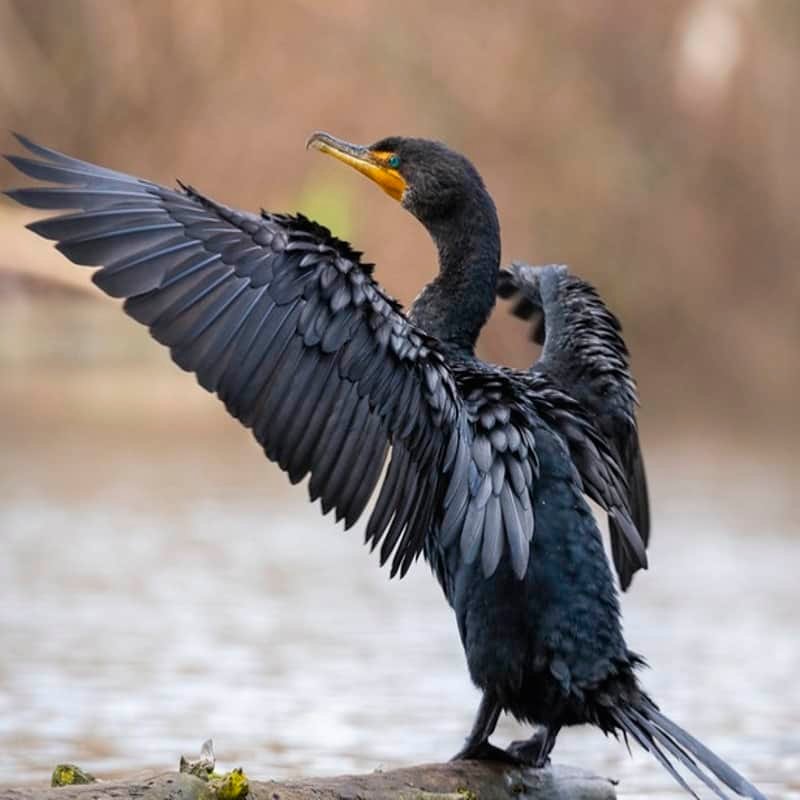The double-crested cormorant, Nannopterum auritum is a water bird. It lives along rivers, lakes, and coastal environments, and is found across North America, from Alaska’s Aleutian Islands to Florida and Mexico. It is an all-black bird that acquires a modest double crest of black and white feathers during mating season. It features a naked orange-yellow patch of skin. Meat is its major source of food. Its feathers, like all cormorants’, are not waterproof, thus it must dry them after swimming. This bird population has risen dramatically in recent years due to the usage of DDT.
Quick Overview: Nannopterum Auritum – Double-crested Cormorant
Body size: Around 32 in (81 cm) and a weight of 1814 g (64 oz)
Main colors: Black, Brown, Orange- yellow
Range: Throughout the United States
Migratory Bird: Yes
Best time of the year to see in the U.S.: June, July, August, September
Conservation Status: Least Concern
Double-crested Cormorant Description
An adult double-crested cormorant is slightly more than two feet in length and has a wingspan of around four feet. In addition to its dark brown to black feathers and webbed black feet, it has a long hooked beak with an orange- yellow neck pouch, a long tail, and webbed orange toes. Adults have tufts of feathers around their eyes to protect them from the sun. Males and females have similar appearances.

Size
These birds have a length of 32 in (81 cm) and a weight of 1814 g (64 oz). Their wings could range 52 in (132 cm).
Feeding
Double-crested cormorants are predominantly fish eaters, although they also consume insects, crabs, and amphibians in addition to fish. Most of the time, they are seen feeding in shallow water (less than 8 meters deep) within 5 kilometers of coast, diving underwater to grab their food.
Habitat
Coasts, bays, lakes, and rivers are all examples of natural habitats. Being extremely versatile, this species is able to survive and thrive in practically any aquatic environment, including rocky northern beaches, mangrove swamps, big reservoirs, and small inland ponds. Nests are built in trees near or above water, on coastal cliffs, or on the ground on islands, among other places.
Behavior
Double-crested Cormorants hover low on the water’s surface and dive to grab tiny fish, which they eat. Following a successful fishing expedition, they perch on docks, rocks, and tree branches with their wings spread out to dry. In-flight, they frequently move in V-shaped flocks that shift and reassemble as the bird’s alternate bursts of choppy flapping with brief glides, alternating between the two.
Nannopterum auritum Scientific Classification
- Kingdom: Animalia
- Phylum: Chordata
- Subphylum: Chelicerata
- Class: Aves
- Order: Suliformes
- Family: Phalacrocoracidae
- Genus: Nannopterum
- Species: Nannopterum auritum
Subspecies
There are five subspecies namely N. a. albociliatum Farallon cormorant, N. a. auritum, N. a. cincinnatum white-crested cormorant, N. a. floridanum, Florida cormorant, and N. a. heuretum.
Best time of the year to see
The best time to see these birds in the United States is during the summer season (June – September).
Distribution of the Barred owl in the USA
Breeds locally over much and throughout of the United States, from southern Alaska to Manitoba and Newfoundland and south to Mexico and the Bahamas. Winters mostly on the shores of Alaska, the Baja Peninsula, and southern New England, as well as the Yucatan Peninsula and the Caribbean.
The XXX bird can be found in the following states in the United States – Alabama, Arizona, Arkansas, California, Colorado, Connecticut, Delaware, Florida, Georgia, Hawaii, Idaho, Illinois, Indiana, Iowa, Kansas, Kentucky, Louisiana, Maine, Maryland, Massachusetts, Michigan, Minnesota, Mississippi, Missouri, Montana, Nebraska, Nevada, New Hampshire, New Jersey, New Mexico, New York, North Carolina, North Dakota, Ohio, Oklahoma, Oregon, Pennsylvania, Rhode Island, South Carolina, South Dakota, Tennessee, Texas, Utah, Vermont, Virginia, Washington, West Virginia, Wisconsin and Wyoming.
